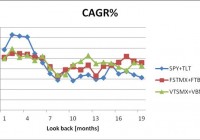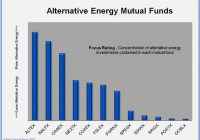Preserve Purchasing Power With This ETF
By Thomas Boccellari Unexpected inflation can be corrosive to a fixed-income portfolio. While bond investors have had to contend with punishingly low interest rates, they have gotten a reprieve on the inflation front. In large part because of falling energy prices, inflation was only 1.3% over the trailing 12 months through November 2014. Because energy is a key input into nearly every aspect of the U.S. economy, it has a big impact on the total cost of production from everything from food and clothing to housing and transportation. Over the trailing 20 years through November 2014, the correlation between WTI Crude and the Consumer Price Index was 0.93. The strength of the U.S. dollar has also been a major contributor to low inflation. Because the eurozone and Japan have weakened their currencies to spur growth in their local markets, the U.S. dollar has strengthened against these currencies. This allows U.S. consumers cheaper access to imported goods from these markets. This is especially important as wage growth remains relatively low in the United States. Because of these trends, expected inflation is low. As of Jan. 12, 2015, the 10-year Treasury’s yield was 1.92%, while the yield of the 10-year TIPS was 0.35%. This implies a break-even inflation rate of 1.57%. The break-even inflation rate is the level inflation would have to increase above before investors would earn higher real returns in Treasury Inflation-Protected Securities. Over the trailing 20 years through November 2014, the average break-even inflation rate was 2.2%. Investors who believe that the long-term inflation will exceed the low-inflation expectations currently priced into traditional bonds may consider a TIPS exchange-traded fund such as Schwab US TIPS ETF (NYSEARCA: SCHP ) –the lowest-cost TIPS ETF available. This fund tracks a broad, market-cap-weighted portfolio of TIPS with more than a year left until maturity. Because TIPS are excluded from aggregate bond ETFs, this fund can be used as a complementary core holding for investors who own an aggregate bond market ETF such as Schwab U.S. Aggregate Bond ETF (NYSEARCA: SCHZ ) (0.06% expense ratio). Because more than half of the fund’s assets were invested in TIPS with maturities greater than seven years, at the end of December 2014, it had a longer duration (7.7 years) than the non-inflation-protected Barclays U.S. Treasury Bond Index (5.7 years). Duration is a measure of interest-rate sensitivity. Therefore, if interest rates were to increase 1%, investors could expect the fund and the Barclays U.S. Treasury Bond Index to decline by 7.7% and 5.7%, respectively. Generally, TIPS’ inflation adjustment is paid at maturity but taxed annually. To make tax time easier, the fund distributes inflation adjustments to the principal in addition to the coupon payment on a monthly basis. However, the fund may suspend interest payments during periods of deflation. This is because the inflation adjustment will become negative and will be offset against the coupon payments. Fundamental View TIPS combine the security of Treasuries with inflation protection in the form of Consumer Price Index-adjusted principal. The CPI represents the cost of a broad basket of goods and services. Inflation will drive the price of that basket higher, and deflation will make it cheaper. When the CPI goes up, a TIPS’ principal is adjusted upward accordingly. Even though the interest rate on the bond remains the same, the semiannual coupon is paid based on the adjusted principal. Inflation may still not rise substantially enough for TIPS to make sense. If interest rates remain consistent or rise slowly, the fund will likely underperform comparable non-inflation-protected bonds. For example, over the trailing six months through November 2014, U.S. inflation fell to 1.3% from 2.1%. Over this time period, the fund’s return (negative 0.7%) was less than that of the Barclays U.S. Treasury 7-10 Year Index (3.1%). However, if the inflation rate increases rapidly, the fund is likely to outperform the Barclays U.S. Treasury 7-10 Year Index. When the inflation rate increased to 2.1% in June 2014 from 0.9% in October 2013, the fund’s return (3.6%) exceeded that of the index (3.1%). The fund’s long duration (7.7 years) may also negate its inflation-protection benefit. This is because long maturity bonds are more susceptible to changing interest rates, which tend to rise when inflation increases. This is because the Federal Reserve often raises rates in order to curb inflation. If long-term interest rates increase with inflation, it could hurt the fund’s returns. For example, from July 2012 through July 2013, the 10-year Treasury yield increased to 2.6% from 1.5%. Over the same period, inflation increased to 2.0% from 1.4%. Despite the increase in inflation, the fund’s return (negative 4.2%) was less than that of the Barclays U.S. Treasury 7-10 Year Index (negative 3.7%) because of the fund’s longer duration. However, long-term interest rates have historically been less volatile than short-term rates. However, Federal Reserve action generally has a larger impact on short- and intermediate-term yields and less on long-term yields. This is because the Fed relies primarily on open market operations to influence short-term interest rates. If the Fed increases short-term interest rates to curb inflation and long-term rates remain relatively stable, the fund may not experience a significant loss. Portfolio Construction The fund tracks the Barclays U.S. Treasury Inflation Protected Securities (TIPS) Index (Series-L), which includes all TIPS issued that have at least one year left until maturity and $250 million in par value. The index is market-cap-weighted and rebalanced monthly. While TIPS are less liquid than Treasuries, the fund’s full index replication strategy has helped to minimize its index tracking error. Fees The fund charges 0.07% annually and is currently the cheapest TIPS ETF. Over the trailing three years through December 2014, the fund has lagged its benchmark by 0.09%, slightly greater than the amount of its expense ratio. Alternatives The largest and most liquid TIPS ETF is iShares TIPS Bond (NYSEARCA: TIP ) (0.20% expense ratio). It tracks the same index as SCHP. SPDR Barclays TIPS ETF (NYSEARCA: IPE ) (0.1865% expense ratio) tracks the Barclays U.S. Government Inflation-Linked Bond Index. While similar to the index that SCHP and TIP track, IPE requires that TIPSs have a minimum $500 million outstanding. As of December 2014, IPE had a shorter duration (6.1 years) and lower yield (1.8%) than SCHP and TIP. Shorter-duration TIPS indexes are somewhat more correlated to inflation, given their lower interest-rate sensitivity. Vanguard Short-Term Inflation-Protected Securities ETF (NASDAQ: VTIP ) (0.10% expense ratio) tracks an index that targets TIPS with maturities of less than five years. As a result, its duration (1.4 years) is considerably lower than SCHP’s. However, it also has a lower yield (0.9%). Another option is PIMCO 1-5 Year U.S. TIPS ETF (NYSEARCA: STPZ ) (0.20% expense ratio), which tracks a similar index as VTIP. Actively managed PIMCO Real Return (MUTF: PRTNX ) (0.85% expense ratio for A share class) has a Morningstar Analyst Rating of Silver. This fund follows a benchmark of TIPS and inflation-linked bonds but tries to garner additional returns through active bets. Disclosure: Morningstar, Inc. licenses its indexes to institutions for a variety of reasons, including the creation of investment products and the benchmarking of existing products. When licensing indexes for the creation or benchmarking of investment products, Morningstar receives fees that are mainly based on fund assets under management. As of Sept. 30, 2012, AlphaPro Management, BlackRock Asset Management, First Asset, First Trust, Invesco, Merrill Lynch, Northern Trust, Nuveen, and Van Eck license one or more Morningstar indexes for this purpose. These investment products are not sponsored, issued, marketed, or sold by Morningstar. Morningstar does not make any representation regarding the advisability of investing in any investment product based on or benchmarked against a Morningstar index.

